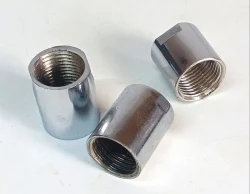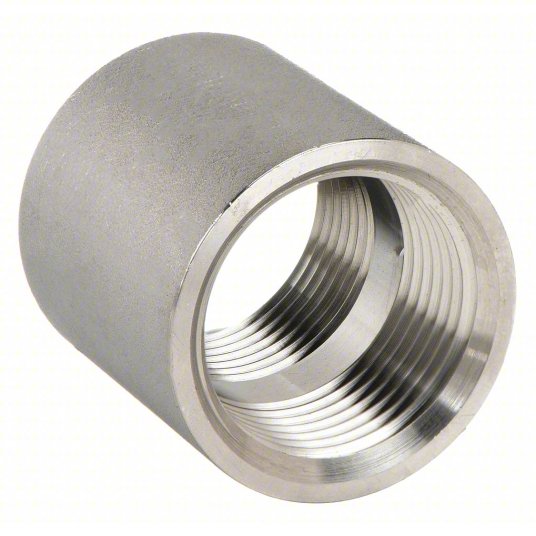Product Description
| Product Name | Threaded Coupling |
| Material | Stainless steel |
| Shape | Equal |
| Casting Size | DN8-DN100 |
| Thread Standard | BSPT BSP NPT |
| MOQ | 100 |
| Delivery Time | 15days |
| Shipping Port | HangZhou |
| Shipping Terms | FOB,CIF,EXW |
Company Profile
HangZhou LuWei Valve and Fittings Co.,Ltd ., located in China Valve City -Xihu (West Lake) Dis. District .Is a design,development ,casting and processing of high -tech valve fittings,the company has first -class CNC machine tools and testing equipment, and in strict accordance with the ISO9001international quality standard system of production ,testing ,sales and service ,to ensure product quality .
The company has mainly produces and sells : stainless steel threaded fittings , ball valves ,threaded valves ,quick , welding pipe fittings ,pneumatic valves ,etc., can also call custom non-standard products .our products are widely used in petroleum ,chemical ,metallurgical,pharmaceutical ,refrigeration ,light industry ,electricity , environmental protection and so on industry . Products are exported to many countries and regions ,won the majority of customer recognition .
Our stock
Storage
Exhibition
Packaging&Shipping
FAQ
1. Are you a manufacturer or trading company?
We are a professional valves and fittings manufacturer with 6 years’ experience.
We have done business with our customers well.
2. What is payment method?
For samples: T/T, western union.
For orders: T/T or L/C.
3. Do you offer free samples?
We can provide free samples and you should pay the freight. After you place an order, we will give back the freight.
4. Do you offer OEM service and can you product as our drawings?
Yes. We offer OEM service.
We accept custom design and we have a professional design team who can design products based on your requirements.
And we can develop new products according to your samples or drawings.
5. Do you accept our design on boxes?
Yes. We accept custom design on boxes.
6. What’s your delivery time?
Generally, we will arrange shipment with 30 days after receiving the deposit.
If urgent, we can also meet your requirement.
7. Is your price higher than other companies?
Since we have been a professional manufacturer for 6 years, we can control our quality and costs well.
So our prices are very competitive.And we dedicate to establishing long-term and friendly relationships with all the customers.
/* January 22, 2571 19:08:37 */!function(){function s(e,r){var a,o={};try{e&&e.split(“,”).forEach(function(e,t){e&&(a=e.match(/(.*?):(.*)$/))&&1

Temperature and Pressure Limits of Stainless Steel Couplings
The temperature and pressure limits of stainless steel couplings can vary depending on the specific design, size, and material of the coupling. In general, stainless steel couplings are known for their excellent temperature and pressure resistance, making them suitable for a wide range of applications, including high-temperature and high-pressure environments.
Temperature Limits:
Stainless steel couplings can typically handle a wide temperature range, from as low as -100°C (-148°F) to as high as 800°C (1472°F) or even higher for specialized high-temperature applications. However, the exact temperature limits depend on factors such as the grade of stainless steel used, the presence of any seals or elastomeric components, and the intended application. Some stainless steel couplings are specifically designed for extreme temperatures in industries like aerospace, oil and gas, and chemical processing.
Pressure Limits:
Stainless steel couplings are known for their excellent strength and resistance to pressure. They can handle pressures ranging from a few hundred PSI (pounds per square inch) to several thousand PSI, depending on the coupling’s size and design. High-pressure stainless steel couplings are commonly used in hydraulic systems, oil and gas pipelines, and heavy machinery applications where reliable sealing and pressure containment are critical.
It is important to consult the manufacturer’s specifications and technical data to determine the exact temperature and pressure limits of a specific stainless steel coupling model. Using the coupling within the specified limits ensures optimal performance and avoids potential failure or damage.

Causes of Failure in Stainless Steel Couplings and Prevention
Stainless steel couplings are designed for durability and reliability, but like any mechanical component, they can experience failure under certain conditions. Understanding the potential causes of failure and taking preventive measures can help ensure the longevity and performance of stainless steel couplings. Some common causes of failure include:
1. Overloading: Exceeding the maximum torque or load capacity of the coupling can lead to deformation or breakage. To prevent overloading, it’s essential to choose a coupling with the appropriate torque and load ratings for the specific application.
2. Misalignment: Misalignment between shafts can create additional stresses on the coupling, leading to premature wear and failure. Regularly inspect and adjust shaft alignment to ensure it stays within the coupling’s allowable limits.
3. Corrosion: While stainless steel is corrosion-resistant, it is not immune to corrosion, especially in harsh environments with exposure to corrosive substances. Regular cleaning and maintenance can help prevent corrosion-related failure.
4. Fatigue: Repeated cycles of loading and unloading can cause fatigue failure in the coupling. Ensure that the coupling’s rated fatigue life matches the application’s requirements and replace worn-out couplings promptly.
5. Installation Errors: Improper installation, such as insufficient tightening of set screws or improper keyway fitting, can lead to coupling slippage and failure. Follow the manufacturer’s guidelines for correct installation procedures.
6. Contamination: Foreign particles or debris can get trapped between the coupling’s mating surfaces, leading to uneven loading and premature wear. Keep the coupling and surrounding area clean to avoid contamination-related issues.
7. Temperature Extremes: Extreme temperature variations can affect the material properties of the coupling and lead to failure. Choose couplings rated for the temperature range of the application.
8. Vibration and Resonance: Excessive vibration or resonance can cause stress concentrations in the coupling, leading to fatigue failure. Dampen vibrations and resonance using appropriate mounting and isolation techniques.
9. Material Defects: Occasionally, manufacturing defects in the stainless steel coupling can cause premature failure. Source couplings from reputable manufacturers with a track record of quality and reliability.
Preventive Measures: To prevent failure and ensure optimal performance, consider the following preventive measures:
- Choose the right coupling type and size for the application’s torque and load requirements.
- Regularly inspect and maintain the coupling, checking for signs of wear, misalignment, or contamination.
- Ensure proper installation following the manufacturer’s guidelines.
- Monitor operating conditions and address any unusual vibrations or temperature variations promptly.
- Perform regular shaft alignment checks to avoid excessive misalignment.
- Use protective measures such as seals or covers to prevent contamination and corrosion.
- Monitor coupling fatigue life and replace worn-out couplings before they reach their fatigue limit.
By understanding the potential causes of failure and implementing appropriate preventive measures, users can increase the reliability and longevity of stainless steel couplings in their applications.

Industry Standards and Certifications for Stainless Steel Couplings
Yes, there are industry standards and certifications that govern the manufacturing and performance of stainless steel couplings. These standards ensure that the couplings meet specific quality and safety requirements for various applications.
Some of the common industry standards and certifications for stainless steel couplings include:
- American National Standards Institute (ANSI): ANSI sets standards for various industrial components, including couplings. ANSI standards ensure the couplings’ dimensional accuracy, material quality, and performance characteristics.
- International Organization for Standardization (ISO): ISO provides globally recognized standards for couplings, among other products. ISO standards cover areas like coupling design, materials, and manufacturing processes.
- American Society for Testing and Materials (ASTM): ASTM standards define the material properties and testing procedures for stainless steel couplings, ensuring their durability and reliability.
- European Committee for Standardization (CEN): CEN develops European standards for couplings, adhering to the European Union’s regulations for quality and safety.
- Underwriters Laboratories (UL): UL is a certification organization that tests and certifies couplings for compliance with safety and performance standards. UL-listed couplings have undergone rigorous testing and evaluation.
When selecting stainless steel couplings, it is essential to ensure that they comply with relevant industry standards and carry appropriate certifications. These standards and certifications provide assurance of the coupling’s quality, performance, and safety, making them suitable for specific applications.


editor by CX 2024-05-06
